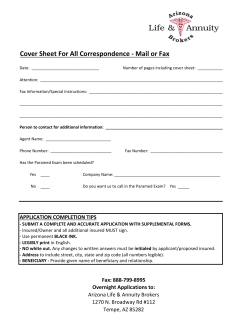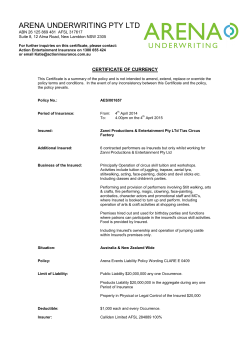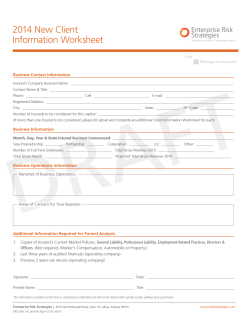
CLIENT BRIEFING
May 2015 CLIENT BRIEFING FIRE SERVICE LEVY DECISION BY THE SUPREME COURT OF NEW ZEALAND On 13 May 2015 the Supreme Court released its decision regarding declarations sought by the Insurance Brokers Association of New Zealand Inc (IBANZ) and Vero relating to tiered material damage policies and material damage policies insuring collectives of insureds; and the calculation of the Fire Service levy. The Fire Service levy is the primary source of funding for the New Zealand Fire Service. It is payable by parties who have insurance, which covers the peril of fire for property situated in New Zealand. The levies are collected by insurance brokers and insurance companies and paid to the Fire Service. The levy for property insurance policies is typically calculated by applying the rate of the levy to the indemnity value of the property insured or the sum insured for property, whichever is the lesser. However, a section of the Fire Service Act states that excess of indemnity insurance does not incur a levy. This has resulted in the use by some insureds of tiered property policies, which separate indemnity insurance from excess of indemnity insurance and place a cap on the indemnity cover. Relying on this section the levy is calculated on the sum insured of the indemnity cover and not the excess of indemnity cover. A policy structure of this type suits clients who insure property situated on multiple sites around New Zealand who are able to calculate a worst case loss for their New Zealand property arising from one event. If this sum was less than the indemnity value of all their property they could decide to limit their sum insured for indemnity value to this worst case figure, effectively assuming some risk of under-insurance but gaining the benefit of minimising FSL. Taking this approach to another level, some groups of insureds who have similar businesses have got together and agreed to a collective approach to their property insurance, sharing the policy limits. This had the potential to substantially reduce the amount of levy otherwise payable in total by the individual businesses. There are other benefits for example with respect to minimising the total amount of insurance market capacity required compared to individual policies and coverage with less restrictive terms and conditions, using the greater leverage gained by the collective approach. The Supreme Court has overturned the decisions of the High Court and Court of Appeal, which had earlier ruled that tiered wordings were effective to allow insureds to limit their Fire Service levies. The result is that, in nearly all situations, insureds will be required to pay a levy calculated on the total indemnity value of all of their insured property. An exception is the situation where the property sum insured is less than this indemnity value, in which case the levy will be calculated on that sum insured. The Supreme Court also decided that an example policy placed for a collective of different insureds in the same industry was in effect eight different contracts, rather than one contract of insurance, despite the fact that the insureds shared the same overall coverage limits within the same policy document. In association with the decision noted above, this means that in this example each insured is liable for Fire Service levies which are to be calculated on the lesser of the indemnity value of all of their insured property, or the total sum insured for property in the collective’s policy. The Supreme Court decision is a long and complicated document and there are many stakeholders in the insurance industry and associated with the insurance industry currently reviewing them. CLIENT BRIEFING: FIRE SERVICE LEVY DECISION BY THE SUPREME COURT OF NEW ZEALAND However, there are some implications of the decisions which are obvious and these are outlined below. 1. I have a tiered policy/I am a participant in a collective policy a. Is there any other legal avenue to appeal to regarding the decision? No b. Will I be liable to pay additional levies/penalties/interest on current or past policies? The Supreme Court’s judgment records that the Fire Service will not seek to apply payment of levies for policies entered into before the Supreme Court’s decision in their favour. The Fire Service would need to publicly confirm this position before one is certain there will be no retrospective levies/penalties/interest c. Will I keep my tiered/collective policy at the next renewal? Tiered policies will not be renewed. Insurance including the peril of fire will be arranged from your renewal date on the usual single policy/single policy limit basis Collective policies are still an appropriate method of reducing the amount of insurance market capacity required when compared to the alternative of each participant seeking an individual policy limit and leveraging better terms and conditions of cover. So yes, your collective policy can be renewed 2. I have a policy with a combined Material Damage and Business Interruption limit What will my levy be calculated on? The lesser of the total indemnity value of all insured property, or the policy limit. If you split the material damage and business interruption into separate sums insured the levy will be calculated on the lesser of the total indemnity value of all insured property, or the material damage limit. The levy is not payable on standalone business interruption limits 3. I have a policy with separate sums insured for Material Damage and Business Interruption What will my levy be calculated on? The levy will be calculated on the lesser of the total indemnity value of all insured property, or the material damage limit. The levy is not payable on standalone business interruption limits 4. My policy has an aggregate limit for fire losses Will my policy have this limitation in future? It will always be an option for you – you may achieve a lower premium than if the limit was removed If your property sum insured exceeds the indemnity value of all insured property you could remove the aggregate limit and return to automatic reinstatement of the limit subsequent to a loss with no fear of increasing your levy If the indemnity value of all insured property exceeds the property sum insured the current reason for having an aggregate limit – to avoid being potentially liable for a levy on the total indemnity value – is still valid 5. Will my levies go down? In the short term the answer is no and, with reference to insureds who have a tiered policy or a collective policy, the amount of levy paid is most likely going to increase substantially. In time we presume that the rate of the levy will be reduced. The reason is that the current amount of levies collected effectively fully fund the Fire Service - so the result of calculating levies on a greater total indemnity value pool measured nationally at the current rate would result in an unnecessary surplus of funds for the Fire Service. The levy rate should reduce so that the revenue it generates only meets the Fire Service’s budgetary needs 2 CLIENT BRIEFING: FIRE SERVICE LEVY DECISION BY THE SUPREME COURT OF NEW ZEALAND 6. Will these decisions prompt a legislative change, to the extent that the levy is not collected only from those with fire insurance, but on a more broadly based approach to who should pay the levy and thus contribute to the funding of the Fire Service? There have been reviews in the past but nothing has come of them. Generally the reviews have focussed on changing the current approach only to the extent of an alternative way of levying parties who have fire insurance. The Supreme Court decisions may result in a lot more focus on alternatives to the current approach of funding the Fire Service primarily from parties who have fire insurance FOR FURTHER INFORMATION All clients with tiered or collective policies will soon be contacted in person by their Marsh Client Executive to discuss the implications to them of the decision. If you have any questions about Fire Service levies in the interim, please contact us. 0800 627 744 marsh.co.nz Disclaimer: Statements concerning legal matters should be understood to be general observations based solely on our experience as insurance brokers and risk consultants and should not be relied upon as legal advice, which we are not authorised to provide. All such matters should be reviewed with your own qualified legal advisors. The information contained in this publication is based on sources we believe reliable, but we do not guarantee its accuracy. This information provides only a general overview of the subjects covered. NZM_A_15-1233 Copyright 2015 Marsh Ltd. All rights reserved.
© Copyright 2025









